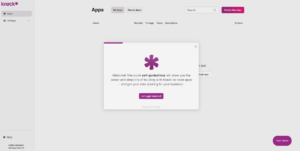
A construction estimate form is a vital tool for planning and budgeting projects, allowing you to track costs like labor, materials, and equipment with precision.
With a no-code platform, creating custom construction forms is simple and efficient—whether you need to manage detailed project estimates, track bids, or monitor equipment usage. This guide will walk you through the process step-by-step, so you can streamline your construction workflows and improve project outcomes.
Key Takeaways
- A construction estimate form is a tool to accurately calculate project costs, including direct costs like materials and labor, as well as indirect expenses like equipment depreciation and office salaries. Common use cases include project budgeting, competitive bidding, and cost tracking.
- The easiest way to create a construction estimate form is by using no-code tools like Knack, which allow you to design forms tailored to your needs with features like automated calculations and real-time data tracking.
- A well-structured construction estimate form should include fields for client and project details, cost categories (labor, materials, equipment, etc.), a total estimate, and additional notes or approvals.
How to Create a Construction Estimate Form With Knack
A well-structured construction estimate form is essential for managing project costs and creating accurate budgets. You can improve decision-making, streamline workflows, and present competitive bids by organizing key information—like material costs, labor expenses, and equipment fees—into a clear format.
With Knack’s no-code platform, there are two main ways to create a construction estimate form: using the AI App Builder for a guided setup or building one from scratch for complete customization. Both methods allow you to tailor forms to your unique needs, ensuring your data is well-organized and easy to manage.
Knack’s no-code development tools offer a range of features to enhance your forms, including automated calculations, real-time data tracking, and customizable user interfaces. These benefits make it simple to design forms that save time, reduce errors, and improve collaboration across teams.
Read more: What is Project Cost Estimation? A Complete Guide
Method 1: Building a Construction Estimate Form with Knack’s AI App Builder
Knack’s AI App Builder simplifies the process of creating a construction estimate form by guiding you through each step. In just a few clicks, you can design a form tailored to your needs, complete with key fields and features to streamline project budgeting.
Step 1: Log In to Your Knack Account
Start by logging in to your Knack account. Once logged in, access your dashboard to begin the process.
Step 2: Create a New App
Click on the “Create New App” button on your dashboard (located in the top right-hand corner). Select the AI Builder option to let the AI assist in setting up your app.
Step 3: Describe Your Construction Estimate Form
Provide clear prompts to guide the AI in creating your form. For example:
“Create an estimate form app for construction projects to calculate material costs, labor expenses, and overall project budgets.”
“Build an app for generating and managing construction estimates with fields for project details, client information, and cost breakdowns.”
Step 4: AI-Generated Form Structure
Review the proposed form structure once the AI generates your app to ensure it meets your requirements. Key fields should include:
- Client Information: Name, contact details.
- Project Details: Name, ID, location, start date, and estimated completion date.
- Cost Categories: Labor, materials, equipment, permits, and miscellaneous expenses.
- Total Estimate: Automated summation of all cost categories.
- Additional Notes/Comments: Space for any additional project details.
Step 5: Customize the Form
Refine the AI-generated structure by modifying field labels, properties, and types:
- Adjust field types (e.g., dropdowns for predefined options or currency fields for cost inputs).
- Add validations to ensure data accuracy, such as requiring numeric inputs for cost-related fields.
Step 6: Test and Publish
- Use the “Live App View” (top right-hand corner) to preview the form and perform test entries.
- Return to the “Builder” view to make adjustments based on your testing feedback.
- Once satisfied, publish the form and configure access permissions to control who can view and edit the form.
Read more: Using a No-Code Form Builder
Method 2: Building a Construction Estimate Form from Scratch
Knack allows you to build a construction estimate form from scratch for maximum flexibility. This method ensures you can fully customize the form’s structure and fields to meet your specific requirements.
Step 1: Start Your Project
- Log in to your Knack account and navigate to your dashboard.
- Click “Create New App” (located in the top right-hand corner) and select the “Build from Scratch” option.
Related: Construction Forms Simplified – The Digital Transformation Guide
Step 2: Set Up the Database
- Create a main table named “Construction Estimates” to organize your data.
- Add the following fields:
- Client Information: Name, email, phone.
- Project Details: Name, ID, start and end dates, location.
- Cost Breakdown:
- Labor Costs (Currency)
- Material Costs (Currency)
- Equipment Costs (Currency)
- Permits/Fees (Currency)
- Miscellaneous Costs (Currency)
- Total Estimate: A currency field that automatically calculates the sum of the cost breakdown.
- Approval Status: A dropdown field with options like Pending, Approved, and Rejected.
Optional: Create additional linked tables for specific needs, such as:
- Labor Logs: Track hours worked by employees.
- Material Tracking: Monitor quantities and usage of materials.
- Invoice Management: Organize invoices related to the project.
Related: Top Construction Management Software for General Contractors
Step 3: Build the Form Page
- Go to the “Pages” section (located within the column on the left-hand side) and click “Add Page”.
- Select “Form” as the page type and link the form to the “Construction Estimates” table.
- Customize the form:
- Drag and drop fields into the layout in the desired order.
- Configure properties like required fields and default values.
- Add tooltips for clarity, such as “Enter labor costs in USD.”
Step 4: Enhance with Automations
- Set up automations to streamline workflows and minimize manual tasks:
- Notify project managers when a new estimate is submitted.
- Automatically calculate the total estimate when individual cost fields are filled.
- Use Knack’s automation tools to define triggers and actions for each workflow.
Related: 10 Tips to Reduce Construction Costs for Projects
Step 5: Review, Test, and Publish
- Test the form in “Live App View” (top right-hand corner) by performing sample submissions.
- Return to the “Builder” view to refine the form based on testing feedback.
- Once finalized, publish the form and configure user permissions:
- Assign roles to stakeholders such as project managers or the finance team.
- Share the form link directly with users or embed it on your website for easy access.
Read more: From Paper to Digital: Transforming Work Order Forms (Guide)
Key Components of a Construction Estimate Form
A well-structured construction estimate form should include the following essential components to ensure accuracy, transparency, and completeness. Each section helps capture key details needed for effective project management and communication.
1. General Project Information
This section provides an overview of the project and client details:
- Project Name
- Project ID or Reference Number
- Project Location
- Client Name and Contact Information
- Phone Number
- Email Address
2. Scope of Work
Outline the specific tasks and deliverables included in the project, along with any exclusions:
- Description of the Project Scope
- Specific Tasks and Deliverables
- Exclusions (if any)
Related: Best Practices for Time Management in Construction Projects
3. Cost Breakdown
Detail the costs associated with each aspect of the project for a transparent estimate:
- Labor Costs
- Type of Work (e.g., plumbing, electrical, framing)
- Hourly Rate or Flat Fee
- Estimated Hours
- Material Costs
- List of Materials Needed
- Quantity and Unit Price
- Subtotal for Materials
- Equipment Costs
- Machinery Rental or Purchase
- Operational Costs (e.g., fuel, maintenance)
- Subtotal for Equipment
- Permits and Fees
- Permitting Costs
- Inspection Fees
- Miscellaneous Costs
- Transportation
- Overhead Expenses
- Contingency Costs (optional)
4. Timeline and Schedule
Establish project deadlines and milestones:
- Estimated Start Date
- Estimated Completion Date
- Milestone Deadlines (if applicable)
5. Payment Terms
Define clear terms for financial transactions:
- Total Estimated Cost
- Deposit or Down Payment (if applicable)
- Payment Schedule (e.g., milestones, monthly)
- Accepted Payment Methods (e.g., check, credit card, bank transfer)
6. Additional Details
Include any special instructions or legal terms to clarify expectations:
- Special Instructions or Notes
- Warranty or Guarantee Details
- Terms and Conditions
- Validity of the Estimate
- Cancellation or Modification Policy
7. Approval Section
Obtain necessary approvals to finalize the estimate:
- Client Signature and Date
- Contractor Signature and Date
8. Optional Attachments
Provide supporting documents to enhance the estimate:
- Detailed Work Plans or Blueprints
- Material Specifications
- Licensing and Insurance Certificates
- References or Past Project Examples
Related: Construction Forms Simplified – The Digital Transformation Guide
Create a Construction Estimate Form with Knack
In today’s competitive construction industry, precision, efficiency, and adaptability are key to staying ahead. While traditional tools may suffice for basic needs, they often fall short in offering the customization and flexibility required for scalable growth. Knack provides the perfect solution, empowering you to create tailored construction estimate forms and management apps without any coding expertise. Whether you use pre-designed templates, the AI App Builder, or start from scratch, Knack’s intuitive platform adapts to your unique needs, helping you save time and streamline operations.
Ready to elevate your construction estimating process? Start building with Knack today and discover how easy it is to create custom solutions that enhance accuracy, efficiency, and collaboration. Begin your 14-day free trial and take the first step toward a smarter, more efficient construction management system.

